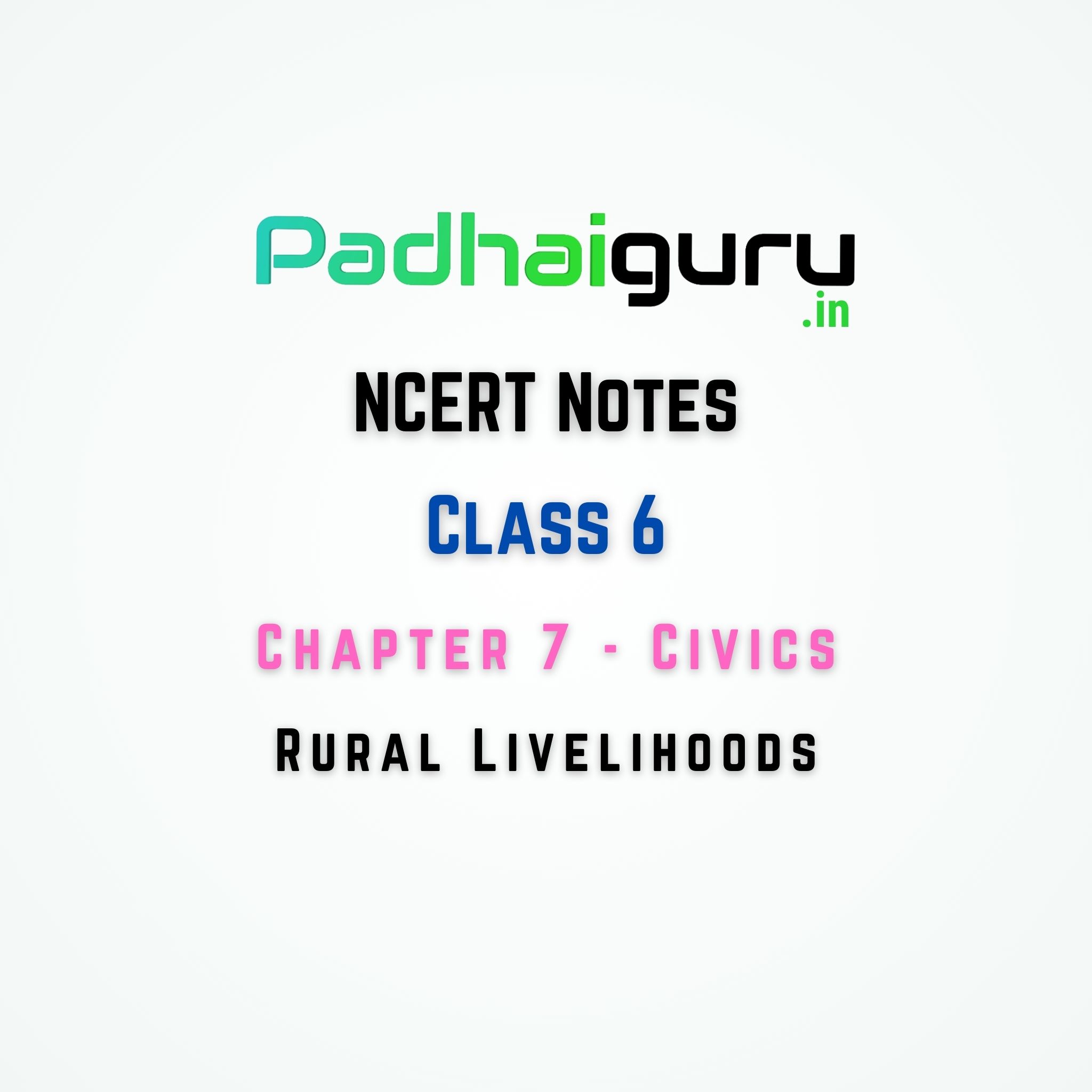07. Rural Livelihood Class 6 NCERT Notes for chapter 7 Social Science – Civics

Welcome to Rural Livelihood Class 6 NCERT Notes for chapter 7 Social Science – Civics specially created by padhaiguru.in .
Rural Livelihood: A Glimpse into Kalpattu Village
Introduction to Village : Kalpattu
Kalpattu is a coastal village located in Tamil Nadu. The village’s livelihoods are diverse, encompassing both farm and non-farm activities. In this article, we will explore the various forms of livelihoods that sustain the residents of Kalpattu village.
Diverse Livelihood Activities
- Non-Farm Work: Similar to other villages, Kalpattu has a range of non-farm activities such as basket weaving, pottery, brick-making, and bullock-cart construction. Additionally, there are service providers such as blacksmiths, nurses, teachers, and mechanics.
- Shopkeepers and Traders: The village boasts shopkeepers and traders who sell goods in a bazaar-like street. Tea shops offer morning snacks like vadai, bonda, and mysorepak. Nearby, a blacksmith family resides, also operating their workshop.
- Agricultural Laborers: Some residents travel to nearby towns for work as construction laborers and lorry drivers. Others work on farms owned by larger landholders.
- Cultivation and Orchards: Coconut groves, cotton, sugar cane, plantain, and mango orchards dot the landscape, contributing to the village’s agricultural diversity.
Thulasi: Life as an Agricultural Laborer
Thulasi’s life revolves around agricultural labor. She engages in transplanting paddy and weeding, enduring back-breaking work. Her workday stretches from 8:30 in the morning till 4:30 in the evening. Her earnings support her family and children’s education.
Sekar: Small Farmer and Fishing Family
Sekar, a small farmer, cultivates two acres of land and earns a living from his harvest. He also works at a rice mill and sells milk from his hybrid cow. Sekar’s story highlights the challenges of debt and market dynamics for small farmers.
Challenges of Debt and Market Dynamics
- Debt and Crop Failure: Many farmers, like Sekar, rely on loans to purchase essentials like seeds and fertilizers. Crop failure due to poor-quality seeds or adverse weather conditions can lead to increased debt and financial distress.
- Ramalingam: Large Farmer and Entrepreneur: Ramalingam is a large farmer who owns 20 acres of land. His family also operates a rice mill and a shop selling agricultural inputs. His income sources are diverse and varied.
Terrace Farming in Nagaland
Chizami village in Nagaland practices terrace cultivation, where hill slopes are transformed into flat plots for rice cultivation. Villagers work collectively and maintain a sense of community during their farming activities.
Fisher Families: Aruna and Paarivelan
Aruna and Paarivelan are a fishing family living near Kalpattu. They face challenges such as stormy seas and the cyclic nature of fishing. Borrowing money and surviving during lean months are part of their livelihood strategies.
Rural Livelihoods: A Complex Landscape
- Seasonal Dependence: Rural livelihoods are often tied to agricultural seasons, leading to periods of high activity during planting and harvesting.
- Income Diversity: Apart from farming, rural livelihoods include non-farm work, forest collection, animal husbandry, fishing, and more.
- Inequality and Challenges: Inequality exists in rural areas, with disparities between small farmers, laborers, and large landholders. Access to resources, education, and medical facilities remains uneven.
Frequently Asked Questions (FAQs) for Rural Livelihood
1. What types of non-farm activities are prevalent in Kalpattu village?
Kalpattu village residents engage in activities such as basket weaving, pottery, brick-making, and blacksmithing.
2. How do agricultural laborers like Thulasi earn their living?
Agricultural laborers like Thulasi earn their livelihood by engaging in tasks such as transplanting paddy and weeding fields.
3. How do farmers like Sekar manage debt and market dynamics?
Farmers like Sekar often rely on loans for essentials, and crop failure or market fluctuations can result in increased debt.
4. What is terrace cultivation, and where is it practiced?
Terrace cultivation involves creating flat plots on hill slopes for farming. It’s practiced in villages like Chizami in Nagaland.
5. How do fishing families like Aruna and Paarivelan sustain their livelihoods?
Fishing families rely on catamarans and nets to catch fish, but face challenges like stormy seas and cyclic fishing patterns.
6. What challenges do large farmers like Ramalingam face in managing their diverse income sources?
Large farmers like Ramalingam manage various income sources, including farming, mill operation, and shopkeeping. Maintaining profitability and dealing with market changes are challenges they encounter.
7. How does inequality impact rural livelihoods?
Inequality affects rural areas, leading to disparities in access to resources, education, and healthcare. Small farmers and laborers often face more challenges compared to large landholders.
8. What are the effects of cyclic fishing patterns on fishing families like Aruna and Paarivelan?
Cyclic fishing patterns force fishing families like Aruna and Paarivelan to rely on borrowing during lean months when fishing is not viable. This cyclical nature impacts their income and livelihood stability.
9. How does collective work play a role in terrace cultivation, as seen in Chizami village?
In Chizami village, collective work is essential for terrace cultivation. Villagers form groups to clean weeds and maintain fields collectively, fostering a sense of community and shared effort.
10. What are the main challenges faced by rural communities during periods of crop failure?
During crop failure, rural communities face challenges such as increased debt, food insecurity, and reduced income. These challenges can have lasting impacts on their livelihoods and well-being.
Conclusion: Diverse Livelihoods in Rural India
Rural livelihoods are a diverse tapestry encompassing various forms of work, from farming and fishing to non-farm activities. The challenges faced by different individuals and families vary, highlighting the complex nature of sustaining livelihoods in rural areas.
This was the end of ncert notes on Rural Livelihood Class 6 for chapter 7 Social Science – Civics
For more information, refer to NCERT SOLUTIONS, NCERT NOTES, and NCERT BOOKS
